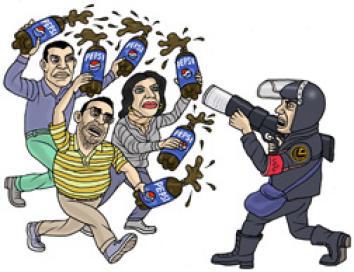Social-networking sites have been critical to organizing demonstrations in Egypt and Tunisia. In addition to coordinating their activities, some protesters have used the Internet to share tips on self-defense, like how to protect yourself from tear gas by pouring Coca-Cola on your face. Other soft drinks have also been used: According to one eyewitness, some Egyptian women noticed that “if you put Pepsi in your eyes, it neutralizes the pain of the tear gas” and began distributing the beverage to their fellow protesters. Does this really work?
No one knows for sure. Both Coca-Cola and Pepsi are acidic, and insurgents and protesters around the world have used acids to minimize the impact of tear gas for decades. Communist Salvadoran guerrillas, for example, used lemon juice in the 1980s, while anti-globalization activists soaked bandanas in vinegar at the Free Trade Association of the Americas summit in 2001. (In terms of pH, Coke and Pepsi are similar to lemon juice, with a pH level of about 2.5. Other types of soda are more basic.) The practice might help prevent the irritant from entering the respiratory system. “Tear gas” isn’t a gas at all, but a cloud of suspended particles that don’t dissolve easily in water, and any kind of wet rag could serve as a filter. It’s possible (but unproved) that an acid-soaked rag would be advantageous given the chemical properties of tear gas. Either way, the tactic has become commonplace among rabble- rousers, and a Pentagon-funded report on nonlethal weapons from 2009 noted in its chapter on tear gas that “a handkerchief soaked in lemon juice can mitigate the weapons’ effects.” That said, no serious medical researchers have tried to demonstrate its efficacy.
There may also be a psychological element to the method. Inhaling pungent lemon juice, vinegar, or even onion fumes might distract protesters from the effects of the tear gas, taking their minds off of the choking haze while they run toward fresh air. Even if an acid-bandana really did eliminate the respiratory effects of tear gas, it probably wouldn’t do much to prevent skin and eye irritation. In addition to its most famous ocular effect, tear gas causes uncontrollable blinking and eye pain, as well as blistering (PDF) or even burns, after heavy exposure. The only evidence that a Coca-Cola bath can stave off any of these symptoms is spotty and anecdotal.
Among doctors, there are two schools of thought on how to counteract the eye effects of tear gas exposure, and neither involves cola. Some favor blowing a fan into the patient’s eyes to try to evaporate any remaining chemicals. Others go straight to irrigating the eyes with copious amounts of saline solution for 10 minutes. There’s also a dispute on skin treatment. Most emergency room doctors wash off the chemical with soap and water. A minority, however, thinks water only intensifies the symptoms and prefers to let the tear gas remnants evaporate on their own. Persistent respiratory symptoms are treated with oxygen or an asthma-style inhaler.
Got a question about today’s news? Ask the Explainer.
Read more of Slate’s coverage of the Egyptian protests.
Explainer thanks Bret Bessac of Texas A&M University.
